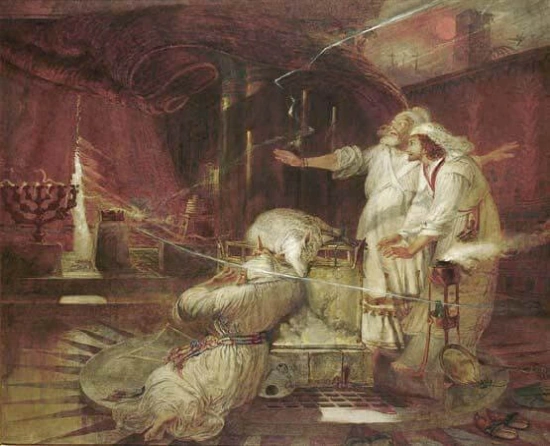In 1 Samuel 1:9, the tabernacle signifies the truth of faith with man. (Arcana Coelestia 2048)
A temple signifies the Lord's spiritual church; in a universal sense, the spiritual kingdom; in the highest sense, the Lord as to His Divine Truth. (Arcana Coelestia 3720)
In 1 Samuel 3:3, when the lamp had not been put out, and Samuel was sleeping in the tabernacle, this signifies that the extinction of truth in worship had not yet been fully accomplished. (Apocalypse Explained 403[18])
In Psalm 65:4, being satisfied with the goodness of the holy place of the temple signifies to be intelligent from divine truth, and to realize heavenly joy therefrom. (Apocalypse Explained 630[11])
In Revelation 21:22, that there is no temple in the New Jerusalem signifies that in that new church, the external worship will not be separate from internal. (Apocalypse Explained 918)
'The Tabernacle,' as in Revelation 13, signifies the church regarding doctrine and worship. 'The tabernacle' has almost the same meaning as 'temple,' that is, in the highest sense, the Lord's divine humanity, and in a relative sense, heaven and the church. But 'tabernacle' as heaven and the church signifies the celestial church, which is in the good of love from the Lord to the Lord, and 'temple,' the spiritual church, which is in the truths of wisdom from the Lord. 'The tabernacle' signifies the celestial kingdom, because the most ancient church, which was celestial, in a state of love to the Lord, performed divine worship in tabernacles. The ancient church, which was a spiritual church, performed divine worship in temples. Tabernacles were made of wood, and temples, stone. 'Wood' signifies good, and 'stone,' truth. Since the most ancient church, a celestial church, because of their love to the Lord, and resulting conjunction with Him, celebrated divine worship in tabernacles, so the Lord commanded Moses to build a tabernacle, which represented everything of heaven and the church. It was so holy, that it was not lawful for anyone to go into it, except Moses, Aaron, and his sons. If any of the people entered, they would die, as in Numbers 17:12-13, 18:1, 22, 23, and 19:14-19. The ark was in its center, which contained the two tables of the Decalogue, and was topped with the mercy seat and the cherubim. Outside of the veil, there were the table for the shew-bread, the altar of incense, and the candlestick with seven lamps. All of these things represented heaven and the church. The Tabernacle is described Exodus 26:7-16 and 36:8-37, and its design was shown to Moses on Mount Sinai, as in Exodus 25:9 and 26:30. Anything seen from heaven is representative of heaven, and so of the church. The feast of tabernacles was instituted in memory of the most holy worship of the Lord in tabernacles by the most ancient people, and of their conjunction with Him by love, as mentioned in Leviticus 23:39-44, Deuteronomy 16:13-14 and Zechariah 14:16-19.
(Referencias:
Apocalypse Revealed 585; Numbers 18:22-23, 19:14-19; Zechariah 14)








